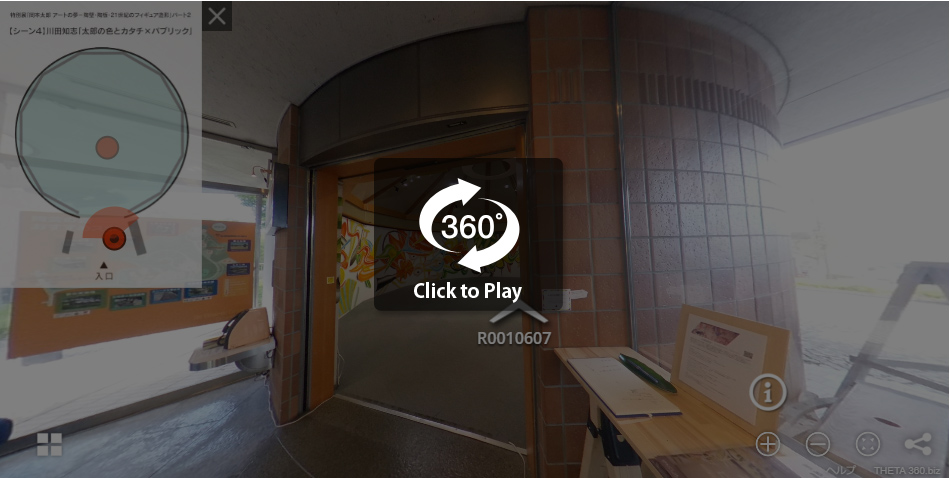 川田知志「太郎の色とカタチ×パブリック」(特別展「岡本太郎 アートの夢」パート 2【シーン4】)
川田知志「太郎の色とカタチ×パブリック」(特別展「岡本太郎 アートの夢」パート 2【シーン4】)
Satoshi Kawata’s Taro no iro to katachi × Public (“Taro’s Color and Form × Public”)
2023(令和5)年9月30日(土)-12月17日(日)
滋賀県立陶芸の森 陶芸館ギャラリー
パノラマVRツアー
|
特別展「岡本太郎 アートの夢」パート 2( 陶芸館ギャラリーで展示) 【シーン4】川田知志「太郎の色とカタチ×パブリック」 |
“壁画は趣味的な美術作品ではなく、社会にうち出すピープルの巨大なマニフェストなのだ。そこに強烈な土地の匂いがふきあがっている”という岡本太郎は、〈社会にとって芸術とは何か〉を生涯にわたり追求し続けた。このシーンでは、今の公共空間における壁画の新たなあり方について国内で数少ない壁画家・川田知志の試みを紹介する。
岡本が絵画を公共空間に提示してきた陶板レリーフなどを、今回の試みで川田はフレスコ画※に再解釈した上で、ふたたび絵画の文脈へ置き換えて新たな眼差しで表現する。この取り組みの面白さは、フレスコ画の移設するために確立された〈ストラッポ〉という古典技法を独自に応用し、壁画を移動可能なアートへと価値を転換しているところだ。場所から解放された彼の壁画は、新たなパブリックアートのあり方を私たちに提示している。
合理と非合理・具象と抽象などの二つの立場が強調しながらぶつかる〈対極主義〉の精神のもとで表現された岡本太郎の芸術。作品とドローイングから、社会に対して公共空間で発信し続けた岡本のメッセージを、川田は建築とカタチとの関連性を探り、信楽での彼の足跡を踏まえて新たな解釈を構築していく。色とカタチという表面的な解釈だけでなく、岡本の芸術の根底にある公共的な場との関係性、信楽の産業的背景を探りながら、壁画やパブリックアートの新たな地平を描き出している。
※フレスコ画(Fresco): 1300年頃にイタリアで出来上がった 漆喰を塗って乾ききらないうちに描く壁画の技法。
Taro Okamoto said: “Murals are not artworks for mere personal pleasure but giant manifestos launched by the public into society. They emit the strong odor of soil.” He dedicated his life to exploring what the arts are to society. Scene 4 features Satoshi Kawata, one of the very few Japanese mural artists, pursuing new possibilities for murals in contemporary public spaces.
Kawata’s works displayed in this exhibition are fresco* reinterpretations of Okamoto’s public-art works, including Ceramic relief murals. Kawata repositions Okamoto’s works in the context of painting and breathes new life into them from a fresh perspective. A highlight of this endeavor is Kawata’s original application of the classical strappo technique, which was established to relocate fresco works, to shifting the value of murals to that of movable artworks. These murals, now free from the restraint of space, show us a new form of public art.
The artworks of Taro Okamoto embody a sharp dichotomy between two conflicting concepts, such as between the rational and the irrational and between the realistic and the abstract under the from his concept of ‘polar opposites’. The messages that Okamoto continued to deliver from public space to society through his works, including drawings, are here reinterpreted by Kawata in pursuit of relationships between architecture and form, while following the trail of Okamoto in Shigaraki. Kawata not only superficially reinterprets the color and form of Okamoto’s works but also shows us a new frontier in murals and public art while exploring the relationship with public space that underlies Okamoto’s works and Shigaraki’s significance as industrial background.
* Fresco is the technique of painting murals on freshly plastered, still moist surfaces, established in Italy around 1300.

